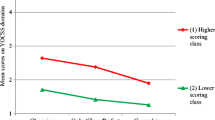Abstract
The extent to which the subscales of multidimensional OCD measures accurately distinguish patients with specific OCD main symptom domains from controls at different cutscores has not yet been examined. Diagnostic accuracy of OCD measures usually is determined by comparing the total scores of heterogeneous OCD samples and controls and therefore may underestimate the measures’ discrimination potential. In the current study, subtype-specific diagnostic accuracy and criterion-related validity of the Obsessive-Compulsive Inventory-Revised (OCI-R) subscales were examined in 327 patients with OCD, anxiety, and/or depressive disorders. All subscales demonstrated good to excellent criterion-related validity and diagnostic accuracy for distinguishing patients with specific OCD main symptom domains from controls. As expected, the single OCI-R subscales lead to more accurate diagnostic decisions than the total scale. Thus, the subscale-specific cutscores significantly improve the OCI-R’s utility for subtype-specific treatment planning and outcome measurement. Furthermore, an alternative classification algorithm distinguishing patients with OCD from controls based on subscale cutscores leads to a better sensitivity, but also to a lower specificity than discrimination based on the total scale cutscore.
Similar content being viewed by others
Notes
Fifty-four patients with OCD who participated in the Gönner et al. (2008) study had to be excluded, because they either did not answer the Y-BOCS-SRS Symptom Checklist (n = 21; at the beginning of the study, the first participants did not receive the Checklist) or did not rate which symptoms of the Checklist are the most severe and impairing obsessions and compulsions (n = 33). Drop-out analyses showed no significant differences between completers and drop-outs in symptom severity and socio-demographic variables like age, sex, and education.
References
Abramowitz, J. S., & Deacon, B. J. (2006). Psychometric properties and construct validity of the Obsessive-Compulsive Inventory-Revised: Replication and extension with a clinical sample. Journal of Anxiety Disorders, 20, 1016–1035.
Antony, M. M., Purdon, C., & Summerfeldt L. J. (Eds.). (2007). Psychological treatment of obsessive-compulsive disorder: fundamentals and beyond. Washington, D.C: American Psychological Association.
Baer, L. (1991). Getting control. Boston: Little Brown & Co.
Baer, L. (1993). Alles unter Kontrolle - Zwangsgedanken und Zwangshandlungen überwinden. [Getting control]. Bern: Huber.
Brown, M. B., & Forsythe, A. B. (1974). The small sample behavior of some statistics which test the equality of several means. Technometrics, 16, 129–132.
Clark, D. A. (2004). Cognitive-behavioral therapy for OCD. New York: Guilford Press.
Foa, E. B., Huppert, J. D., Leiberg, S., Langner, R., Kichic, R., Hajcak, G., et al. (2002). The Obsessive-Compulsive Inventory: Development and validation of a short version. Psychological Assessment, 14, 485–496.
Gönner, S., Leonhart, R., & Ecker, W. (2008). The Obsessive-Compulsive Inventory-Revised (OCI-R): Validation of the German Version in a Sample of Patients with OCD, Anxiety Disorders, and Depressive Disorders. Journal of Anxiety Disorders, 22, 734–749.
Goodman, W. K., Price, L. H., Rasmussen, S. A., Mazure, C., Fleischmann, R. L., Hill, C. L., et al. (1989). The Yale-Brown Obsessive Compulsive Scale. I. Development, use, and reliability. Archives of General Psychiatry, 46, 1006–1011.
Grabill, K., Merlo, L., Duke, D., Harford, K.-L., Keeley, M. L., Geffken, G. R., & Storch, E. A. (2008). Assessment of obsessive-compulsive disorder: A review. Journal of Anxiety Disorders, 22, 1–17.
Hiller, W., Zaudig, M., & Mombour, W. (1995). IDCL. Internationale Diagnosen Checklisten für ICD-10 und DSM-IV. [International Diagnostic Checklists for ICD-10 and DSM-IV]. Bern: Huber.
Huppert, J. D., Walther, M. R., Hajcak, G., Yadin, E., Foa, E. B., Simpson, H. B., et al. (2007). The OCI-R: Validation of the subscales in a clinical sample. Journal of Anxiety Disorders, 21, 394–406.
Leckman, J. F., Mataix-Cols, D., & do Rosario-Campos, M. C. (2005). Symptom dimensions in OCD: Developmental and evolutionary perspectives. In J. S. Abramowitz, & A. C. Houts (Eds.), Concepts and controversies in obsessive-compulsive disorder (pp. 3–25). NY: Springer.
Mataix-Cols, D., Rauch, S. L., Baer, L., Shera, D., Eisen, J., Goodman, W. K., et al. (2002). Symptom stability in adult obsessive-compulsive disorder: Data from a naturalistic two-year follow-up study. American Journal of Psychiatry, 159, 263–268.
Mataix-Cols, D., do Rosario-Campos, M. C., & Leckman, J. F. (2005). A multidimensional model of obsessive-compulsive disorder. American Journal of Psychiatry, 162, 228–238.
McKay, D., Abramovitz, J. S., Calamari, J. E., Kyrios, M., Radomsky, A., Sookman, D., Taylor, S., & Wilhelm, S. (2004). A critical evaluation of obsessive-compulsive disorder subtypes: Symptoms versus mechanisms. Clinical Psychology Review, 24, 283–313.
Menzies, R. G. & de Silva, P. (Eds.). (2003). Obsessive-compulsive disorder: Theory, research, and treatment. Chichester, UK: Wiley.
Schaible, R., Armbrust, M., & Nutzinger, D. O. (2001). Yale-Brown Obsessive Compulsive Scale: Sind Selbst- und Fremdrating äquivalent? [Yale-Brown Obsessive Compulsive Scale: Are self-rating and interview equivalent measures?]. Verhaltenstherapie, 11, 298–303.
Smári, J., Ólason, D. T., Eyþórsdóttir, Á., & Frölunde, M.-B. (2007). Psychometric properties of the Obsessive-Compulsive Inventory-Revised among Icelandic college students. Scandinavian Journal of Psychology, 48, 127–133.
Steketee, G., Frost, R., & Bogart, K. (1996). The Yale-Brown Obsessive Compulsive Scale: Interview versus self-report. Behaviour Research and Therapy, 34, 675–684.
World Health Organization (WHO) (1993). The ICD-10 classification of mental and behavioural disorders, clinical descriptions and diagnostic guidelines. Geneva: WHO.
Author information
Authors and Affiliations
Corresponding author
Rights and permissions
About this article
Cite this article
Gönner, S., Ecker, W. & Leonhart, R. Diagnostic Discrimination of Patients with Different OCD Main Symptom Domains from each Other and from Anxious and Depressive Controls. J Psychopathol Behav Assess 31, 159–167 (2009). https://doi.org/10.1007/s10862-008-9114-0
Published:
Issue Date:
DOI: https://doi.org/10.1007/s10862-008-9114-0




